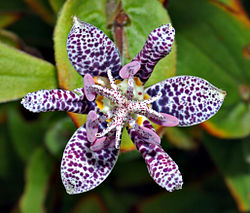Hairy Toad Lily
| Habit | herbaceous
| |
|---|---|---|
| Height: | ⇕ | 36 in"in" can not be assigned to a declared number type with value 36. |
| Width: | ⇔ | 24 in"in" can not be assigned to a declared number type with value 24. |
| Lifespan: | ⌛ | perennial |
| Poisonous: | ☠ | all parts |
| Bloom: | ❀ | early fall, mid fall, late fall |
| Exposure: | ☼ | part-sun |
|---|---|---|
| Water: | ◍ | moist |
| Features: | ✓ | flowers |
| USDA Zones: | 4 to 9 | |
| Flower features: | ❀ | blue, purple |
|
hirta > |
Tricyrtis is a genus of the botanical family Liliaceae, known in English as Toad lilies. Its native range is from the Himalayas to eastern Asia, including China,[1] Japan,[2] Philippines and Formosa.[3]
They are perennial herbaceous plants that grow naturally at the edge of forests. Toad Lilies bloom in the fall. They are hardy enough to handle the sudden changes of Midwest(US) winters from mild to blustery cold.[4]
Read about Hairy Toad Lily in the Standard Cyclopedia of Horticulture
|
|---|
|
Tricyrtis hirta, Hook. (T. japonica, Miq.). St. 1-3 ft. high, everywhere clad with soft whitish spreading hairs: fls. 6-15, racemose or subcorymbose, whitish, the outer segms. covered with rather large purple spots. Widespread in the woods of Japan. Var. nigra, Hort. (T. nigra, Hort.), has black instead of purple spots. A form with variegated lvs. was once offered in this country. CH
|
Cultivation
They prefer shade or part shade and rich, moist soil.
Propagation
By division or seed. Sow seed indoors before last frost
Pests and diseases
- Do you have pest and disease info on this plant? Edit this section!
Species
Gallery
References
- Standard Cyclopedia of Horticulture, by L. H. Bailey, MacMillan Co., 1963
External links
- w:Hairy Toad Lily. Some of the material on this page may be from Wikipedia, under the Creative Commons license.
- Hairy Toad Lily QR Code (Size 50, 100, 200, 500)
- ↑ "Tricyrtis Wallich". Flora of China.
- ↑ Template:Citation
- ↑ Template:Citation
- ↑ Cox, Jeff (1998 by Rodale Press) Perennial All-Stars: The 150 Best Perennials for Great-Looking, Trouble-Free Gardens, pg. 305
